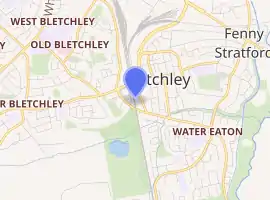Bletchley Flyover
The Bletchley Flyover is a reinforced concrete railway viaduct that carried the former Varsity line over the West Coast Main Line in Bletchley, England. It was retained when the line closed and, as of July 2020, is being restored for use in East West Rail.
Bletchley Flyover | |
|---|---|
.jpg.webp) The flyover from Bletchley railway station on 26 October 2017 | |
| Coordinates | 51°59′32″N 0°44′7″W |
| OS grid reference | SP 868 335 |
| Carries | Varsity line |
| Crosses | West Coast Main Line |
| Locale | Bletchley |
| Owner | Network Rail |
| Characteristics | |
| Total length | 605 metres (1,985 ft) |
| No. of spans | 37 |
| Rail characteristics | |
| No. of tracks | 2 |
| Track gauge | 1,435 mm (4 ft 8 1⁄2 in) |
| Electrified | No |
| History | |
| Opened | 1959 |
| Rebuilt | 2020–2021 |
| Location | |

| |
Construction
The structure is composed of 37 concrete spans,[1] resting on concrete piers. It is 605 metres (1,985 ft) long.[2] Most of the spans are beam-shaped; two are double-length arches. Electrification pads were provided when the flyover was first built, despite there being no plans to electrify the line.
History
In 1959, the Bletchley Flyover was opened to carry the Varsity line over the West Coast Main Line (WCML) as part of the British Rail Modernisation Plan.[3][4] The plan proposed to develop the Varsity Line as a freight link from the East Coast ports to South Wales, capable of handling up to 2,400 wagons of coal class traffic and empties daily.[5] However, following British Railways deciding not to proceed with the Swanbourne sidings plan, the line saw little use, with most freight traffic taking other routes.[6]
The Varsity line closed to passengers on 1 January 1968; it remained open to goods traffic until October 1993, when the bridge was mothballed.[7][8] The flyover was returned to use in 2006 along with a mile of track west of Bletchley to a loop at the Newton Longville Brickworks landfill site.[9]
2020 renovation
As part of the East West Rail project that will reopen the Varsity line route, work to replace 14 of the spans began in April 2020.[8][10][11] Sections beside and over the WCML were removed in April and May.[12][13] The arches crossing Buckingham Road (on the east side of WCML) started being removed on 5 July 2020.[14] As of December 2020, the work is ongoing and includes replacement of the remaining spans over the WCML.[12]
The renovation will allow two elevated platforms to be added to Bletchley station.[15]
References
- Biggest cranes in Europe spotted in Milton Keynes ready for 295-tonne upgrade Milton Keynes Citizen 4 May 2020
- Class 56 special over doomed Bletchley flyover line Rail issue 200 12 May 1993 page 6
- The Bletchley Flyover The Railway Magazine issue 691 November 1958 page 737
- Biggest cranes in Europe spotted in Milton Keynes ready for 295-tonne upgrade Milton Keynes Citizen 4 May 2020
- Klapper, C.F. (1976). London's Lost Railways. London: Routledge & Kegan Paul. p. 101. ISBN 0-710083-78-5.
- Fiennes, G F (1973). "7. Chief Operating Officer, B.R.". I tried to run a Railway (Revised ed.). London: Ian Allan Publishing. ISBN 9780711004474.
- Class 56 special over doomed Bletchley flyover line Rail issue 200 12 May 1993 page 6
- Bletchley Flyover Project Railways Illustrated July 2020 page 12
- Bletchley flyover reconstruction begins Modern Railways issue 861 June 2020 page 18
- Britain’s East-West Rail project makes progress International Railway Journal 4 May 2020
- Three huge cranes remove flyover at Bletchley Rail Engineer 6 July 2020
- Kevin Nicholls (4 May 2020). "Biggest cranes in Europe spotted in Milton Keynes ready for 295-tonne upgrade [as] 60-year-old Bletchley Flyover gets a makeover ahead of Milton Keynes's new East-West rail link". Milton Keynes Citizen. Retrieved 5 May 2020.
- Mark Cuzner (July 2020). "EWR2 Project Newsletter - July 2020". East West Rail Alliance. Retrieved 7 August 2020.
- Sally Murrer (2 July 2020). "Three of UK's largest cranes heave out sections of concrete railway flyover in Milton Keynes". Milton Keynes Citizen. Retrieved 26 July 2020.
- Network Rail gear up to deliver East West Rail East West Rail
External links
Stations in and around Milton Keynes | |||||||||||||||||||||||||||||||||||||||||||||||||||||||||||||||||||||||||||||||||||||||||||||||||||||||||||||||||||||||||||||||||||||||||||||||||||||||||||||||||||||||||||||||||||||||||||||
|---|---|---|---|---|---|---|---|---|---|---|---|---|---|---|---|---|---|---|---|---|---|---|---|---|---|---|---|---|---|---|---|---|---|---|---|---|---|---|---|---|---|---|---|---|---|---|---|---|---|---|---|---|---|---|---|---|---|---|---|---|---|---|---|---|---|---|---|---|---|---|---|---|---|---|---|---|---|---|---|---|---|---|---|---|---|---|---|---|---|---|---|---|---|---|---|---|---|---|---|---|---|---|---|---|---|---|---|---|---|---|---|---|---|---|---|---|---|---|---|---|---|---|---|---|---|---|---|---|---|---|---|---|---|---|---|---|---|---|---|---|---|---|---|---|---|---|---|---|---|---|---|---|---|---|---|---|---|---|---|---|---|---|---|---|---|---|---|---|---|---|---|---|---|---|---|---|---|---|---|---|---|---|---|---|---|---|---|---|---|
| |||||||||||||||||||||||||||||||||||||||||||||||||||||||||||||||||||||||||||||||||||||||||||||||||||||||||||||||||||||||||||||||||||||||||||||||||||||||||||||||||||||||||||||||||||||||||||||
 Media related to Bletchley Flyover at Wikimedia Commons
Media related to Bletchley Flyover at Wikimedia Commons
